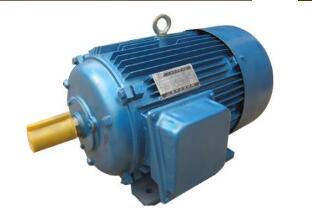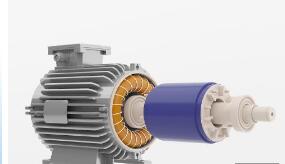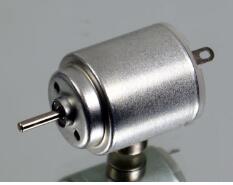This paper first introduces the performance comparison between stepper motor and servo motor. Secondly, it introduces the advantages of servo motor compared with stepper motor. Finally, it explains the principle of motor selection and how to choose servo motor and stepper motor correctly. Get up and find out.
What are servo and stepper motors?A servo motor, also known as an actuator motor, is used as an actuator in an automatic control system to convert an electrical signal received into an angular displacement or angular velocity output on a motor shaft. Divided into two major categories of DC and AC servo motor, its main feature is that when the signal voltage is zero, there is no rotation phenomenon, and the rotation speed decreases uniformly with the increase of torque. The servo is mainly positioned by pulse. It can be basically understood that when the servo motor receives one pulse, it will rotate the angle corresponding to one pulse to realize the displacement. Because the servo motor itself has the function of emitting pulses, the servo motor has every When an angle is rotated, a corresponding number of pulses are emitted, so that the pulse received by the servo motor forms an echo, or a closed loop, so that the system knows how many pulses are sent to the servo motor, and how many pulses are received at the same time. In this way, the rotation of the motor can be controlled very accurately, so that accurate positioning can be achieved, which can reach 0.001 mm.
The stepper motor is a discrete motion device that is intrinsically linked to modern digital control technology. In the current domestic digital control system, the application of stepper motors is very extensive. With the advent of all-digital AC servo systems, AC servo motors are increasingly being used in digital control systems. In order to adapt to the development trend of digital control, stepping motor or all-digital AC servo motor is mostly used as the execution motor in the motion control system. Although the two are similar in control mode (burst and direction signal) elastic coupling, there are large differences in performance and application. Now compare the performance of the two.

First, the control accuracy is different
The two-phase hybrid stepping motor step angle is generally 3.6 °, 1.8 °, and the five-phase hybrid stepping motor step angle is generally 0.72 °, 0.36 °. There are also some high performance stepper motors with smaller step angles. For example, a stepping motor for a slow wire-cutting machine produced by Sitong has a step angle of 0.09°; a three-phase hybrid stepping motor produced by BERGER LAHR can pass the step angle. The DIP switches are set to 1.8°, 0.9°, 0.72°, 0.36°, 0.18°, 0.09°, 0.072°, and 0.036°, and are compatible with the step angle of two-phase and five-phase hybrid stepping motors.
The control accuracy of the AC servo motor is guaranteed by the rotary encoder at the rear of the motor shaft. Taking Panasonic's all-digital AC servo motor as an example, for a motor with a standard 2500-line encoder, the pulse equivalent is 360°/10000=0.036° due to the quadruple frequency technology inside the driver. For a motor with a 17-bit encoder, the drive receives one revolution per 217 = 131072 pulsed motors, ie its pulse equivalent is 360°/131072 = 9.89 seconds. It is 1/655 of the pulse equivalent of a stepping motor with a step angle of 1.8°.
Second, the low frequency characteristics are different
Stepper motors are prone to low frequency vibration at low speeds. The vibration frequency is related to the load condition and the performance of the driver. It is generally considered that the vibration frequency is half of the take-off frequency of the motor no-load. This low frequency vibration phenomenon, which is determined by the working principle of the stepper motor, is very detrimental to the normal operation of the machine. When the stepper motor works at low speed, damping technology should generally be used to overcome the low frequency vibration phenomenon, such as adding a damper to the motor or using subdivision technology on the drive.
The AC servo motor runs very smoothly, and vibration does not occur even at low speeds. The AC servo system has a resonance suppression function, which can cover the rigidity of the machine, and has a frequency analysis function (FFT) inside the system, which can detect the resonance point of the machine and facilitate system adjustment.
Third, the difference in frequency characteristics
The output torque of the stepping motor decreases as the speed increases, and it drops sharply at higher speeds, so the maximum operating speed is generally 300-600 RPM. The AC servo motor is a constant torque output, that is, it can output the rated torque within its rated speed (generally 2000RPM or 3000RPM), and it is a constant power output above the rated speed.
Fourth, the overload capacity is different
Stepper motors generally do not have overload capability. The AC servo motor has a strong overload capability. Take the Panasonic AC servo system as an example, it has speed overload and torque overload capability. Its maximum torque is three times the rated torque and can be used to overcome the moment of inertia of the inertia load at the moment of starting. Because there is no such overload capability in the stepping motor, in order to overcome this moment of inertia during the selection, it is often necessary to select a motor with a large torque, and the machine does not need such a large torque during normal operation, and a torque appears. The phenomenon of waste.
Five, different operating performance
The control of the stepping motor is open-loop control. If the starting frequency is too high or the load is too large, it may be lost or blocked. If the speed is too high during the stop, the overshoot may occur. Therefore, in order to ensure the control accuracy, it should be handled well. The problem of rising and falling speed. The AC servo drive system is closed-loop control. The drive can directly sample the feedback signal of the motor encoder. The internal position loop and speed loop are formed. Generally, the stepless motor is lost or overshooted, and the control performance is more reliable. Sixth, the speed response performance is different
It takes 200 to 400 milliseconds for the stepper motor to accelerate from standstill to the operating speed (typically several hundred revolutions per minute). The AC servo system has better acceleration performance. Taking the Panasonic MSMA 400W AC servo motor as an example, it takes only a few milliseconds to accelerate from standstill to its rated speed of 3000 RPM. It can be used in control applications requiring fast start and stop.
Seven, the price is different
Due to the relatively high manufacturing cost and technical content of the servo motor and its driver, the price is much higher than that of the stepper motor, especially as the price difference between the servo motor and the motor as soon as possible is greater. This year, domestic servo motors have developed rapidly. There are many varieties and models of servo motors to choose from, and the cost performance is also high.
In summary, the AC servo system is superior to the stepper motor in many performance aspects. However, in some occasions where the requirements are not high, stepper motors are often used to perform the motor. Therefore, in the design process of the control system, it is necessary to comprehensively consider the control requirements, cost and other factors, and select the appropriate control motor.

1. Accuracy: realizes closed-loop control of position, speed and torque; overcomes the problem of stepping motor out of step;
2, the speed: high-speed performance is good, the general rated speed can reach 2000 ~ 3000 rpm;
3. Adaptability: It has strong anti-overload capability and can withstand three times the rated torque. It is especially suitable for occasions with transient load fluctuations and quick start.
4. Stable: It runs smoothly at low speed, and does not produce stepping operation similar to stepper motor when running at low speed. Suitable for occasions with high speed response requirements;
5. Timeliness: The dynamics of motor acceleration and deceleration are short, generally within tens of milliseconds;
6, comfort: heat and noise are significantly reduced.
Motor selection principle1. Consider the traditional motor from the cost <stepper motor <servo motor
2, from the motor speed requirements consider the traditional motor speed range is wide but the speed regulation is not accurate and not smooth, and the power will be reduced with the speed reduction, which will bring about the torque reduction; stepper motor requires more stringent speed, speed When it is too low, there will be jitter and creep. When the speed is high, the torque will be greatly reduced, so the stepper motor is only suitable for medium speed operation. The advantage of the servo motor in terms of speed is obvious, and there is basically no obvious weakness.
3. From the control precision, the traditional motor can not guarantee the accuracy because it is analog quantity control. The stepping motor and servo motor are digital signal control whose accuracy is much higher than that of the traditional motor, but the servo motor has an internal encoder for internal closed loop control. The situation of the reduction of the step is reduced, and the servo motor step angle is usually much smaller than that of the stepping motor, so the accuracy is higher.

Mainly depending on the specific application, it is simple to determine: the nature of the load (such as horizontal or vertical load), torque, inertia, speed, accuracy, acceleration and deceleration requirements, upper control requirements (such as port interface and communication Aspect requirements), the main control method is position, torque or speed mode. Whether the power supply is DC or AC, or battery powered, voltage range. This is used to determine the model of the motor and the associated drive or controller.
Conecting Terminals Without Screws
Conecting Terminals Without Screws,Cold Pressing Terminals,Low Pressure Cold Shrinkage Terminal,Cold Shrinkage Cable Terminals
Taixing Longyi Terminals Co.,Ltd. , https://www.lycopperlugs.com